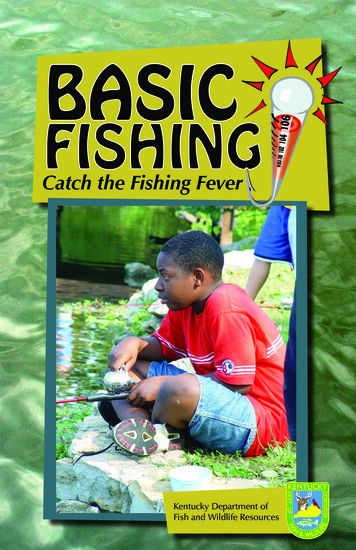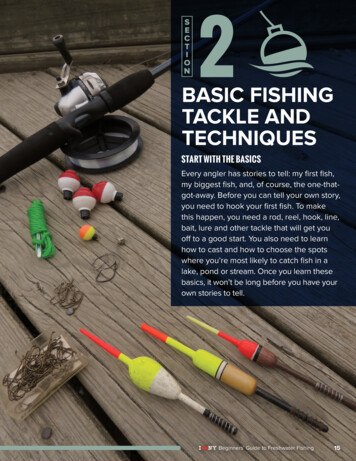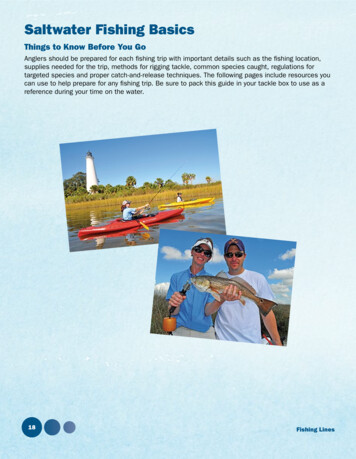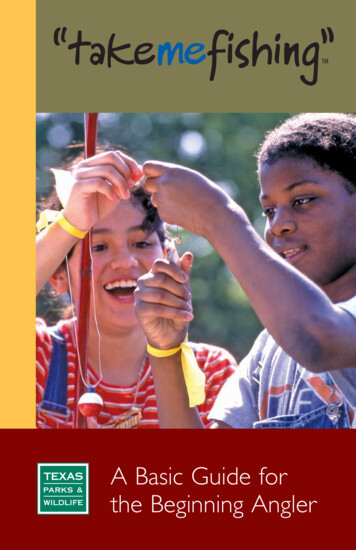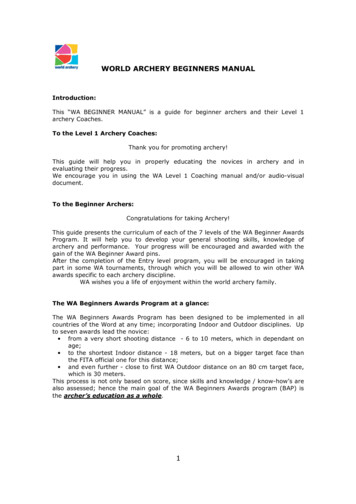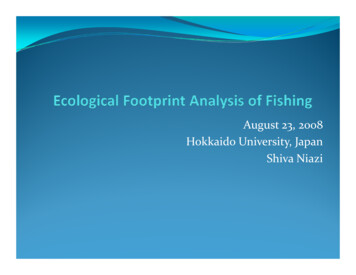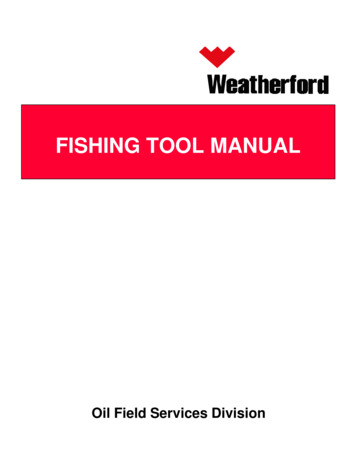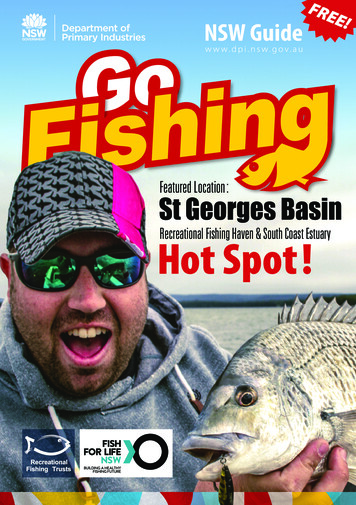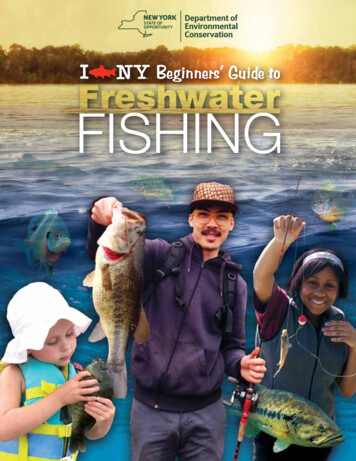
Transcription
Beginners’ Guide toFISHING
BBeginners’ Guide to Freshwater Fishing
Let’s Go Fishing!Fishing is an excellent way to enjoy nature and makelasting memories with family and friends. Anyone—fromchildren to retirees—can learn to fish. Enticing a fish tobite your hook is always fun, and can be as relaxing orchallenging as you decide to make it. Fishing offers anever-ending stream of intriguing experiences: Wade intoa cold, rocky stream fishing for trout. Watch a pink sunsetreflected in a still pond as a bass explodes on your lure.Wonder if you can catch more fish than that osprey flyingoverhead. Let this guide help you take your first step intoa lifetime of fishing fun and adventure.SectionPage1. Fishes of New York. 12. Basic Fishing Tackle and Techniques. 173. Care of Your Catch. 314. Safe and Responsible Angling. 39Beginners’ Guide to Freshwater Fishing
Basic Fishing Tackle and TechniquesDBeginners’ Guide to Freshwater Fishing
SECTIONFishes of New York1Fishes ofNew YorkNew York State is home to more than 165 freshwater fishspecies, including some that were around when dinosaursroamed the land. These fish come in all different sizes,from two-inch darters to sturgeon that can grow to morethan seven feet. They come in all different shapes, too.Sunfish have compressed bodies, whereas commoncarp are fat and round. Pike and pickerel are long andnarrow. The different sizes, shapes and colors are notaccidental—each has a purpose in helping a fish surviveand reproduce.Beginners’ Guide to Freshwater Fishing1
Fishes of New YorkFish SensesWhat makes a fisha fish?Fish use most of the senseshumans do to help them survive intheir environment.Rock BassScales – Most fish have scales thatcover all or a portion of their bodies,protecting them against injury.Catfish and lamprey are exceptions,as their skin is completely scaleless.Fish FeaturesGills – We use our lungs to getoxygen from the air. Fish use theirgills to get oxygen from the water.Without gills, fish cannot live. Thegill cover protects the sensitive gillsfrom injury.Slime – Have you ever held a fish?What does it feel like? Slimy? Slippery?The slime is there for a reason—toprotect fish against diseases andhelp them glide through the water.So before you hold a fish, alwayswet your hands. That way, the slimewill stay where it belongs.The next time you look at a fish, seehow its eyes bulge out of its head.While humans can only see about180 degrees around themselves,fish have a much broader field ofvision and can see 300 degrees.300 fieldofve avishahisonFins – Fins help fish move throughthe water. The caudal (tail) finpushes the fish forward, while theother fins are used for steeringand balance. They allow the fish tostay in one place and to dive to thebottom or rise to the surface.Spines – Some fish, like sunfishand perch, have spines in their finsto protect them against predators.Always be careful when handlingthese types of fish. For tips on howto hold the fish you catch, checkthe Care of Catch chapter.SightFi It lives in water. It has fins. It has gills. It is cold-blooded.60 blindHow old am I?pectoral findorsal fincaudal (tail) finBiologists can use scales orotoliths (ear stones) to age fish.Just as you can age a tree bythe rings in a cross-section of thetrunk, you can estimate a fish’s ageby looking at its scales or otoliths.annular ringsgill cover2pelvic finBeginners’ Guide to Freshwater Fishinganal fin
Fishes of New YorkHearingEven though you can’t see them,fish have an inner ear on each sideof their heads that aids in balanceand allows them to sense vibrationscaused by sounds in the water.That’s why fish spook so easilywhen you’re out fishing.naresLateral LineFish also have a lateral line that runsdown the length of their bodies.This row of special cells helps themsense vibrations caused by otheranimals in the water.barbelsBrown Bullheadlateral lineBody ShapeTasteMost fish have taste buds in theirmouths, but some fish have themin their gills and barbels (whiskers).Catfish, with their very small eyesand poor vision, rely on theirbarbels to locate food. Despitemyths you may have heard, barbelsdon’t sting!SwimbladderSmellEven though they’re underwater,fish have nostrils, or nares, thatthey use to seek out food. Somefish even use their sense of smellto return to their birth streams tospawn (reproduce).We know fins help fish move about,but what is it that keeps themsuspended within a waterbodyinstead of floating to the top orsinking to the bottom? It’s an organcalled the swim bladder. This gasfilled sac can be inflated or deflatedby the fish. When it is filled justright, the fish is “neutrally buoyant,”meaning it won’t sink or float. Thishelps the fish stay exactly where itwants to be without having to swim.A fish’s shape tells you a lot abouthow it lives.Built for speedWith its torpedo-shaped body andlarge fins in the back, chain pickerelare one of the state’s fastest fish.Laying LowCatfish have compressed bodies,large pectoral fins and barbels,making them ideal for living onthe bottom.Did You KnowA freshwater drumcan make a gruntingnoise by vibrating itsswim bladder.Beginners’ Guide to Freshwater Fishing3
Fishes of New YorkColorationWhen it comes to coloration, fishare very good at blending into theirsurroundings. After all, it’s all aboutsurvival.their bodies, they blend in with thebottom when looked at from above.Similarly, by being light colored onthe bottom half of their bodies, theyblend with the light from the surfacewhen looked at from below.After hatching, the young are calledfry. The amount of time it takes for fryto hatch depends on the species andthe water temperature. Young fish,called sac fry, have a yolk sac whichprovides nourishment as they grow.Largemouth bass blending in with its habitatMost fish exhibit countershading, anadaptation that makes them difficultfor predators to see. By havingdark coloration on the top half ofAll living things must reproduce sotheir species continues. Spawningbetween male and female fishoccurs at certain times of the year,usually spring or fall, depending onthe species. Most eggs are laid onplants or on the bottom of a lake orriver, often in nests guarded by themale. Fish that don’t take care oftheir young lay more eggs than fishthat do. After eggs are fertilized, theembryo begins to form in the egg.Sac fryMark BaturLargemouth bass tend to have agreenish color, which helps themblend in with the weedy areaswhere they live. Smallmouth bassprefer rocky areas, so they have abrown body. Sunfish and perch canbe found hiding in plants. Havingvertical bars up and down theirbodies helps them blend in.Mark BaturA Fish’s TaleEventually, the yolk sac is absorbedand fry begin feeding on tiny,microscopic animals calledzooplankton.As they grow larger, the young arecalled juveniles, or fingerlings. Theirdiet consists of aquatic insects andsmaller fish.Fertilized eggs with developing embryosBird’s Eye ViewEver look for fish from a bridge? It’s tough! From above, their dark-coloredbacks make them hard to see against shadowed bottoms. To make it easier,look for fish swimming over light-colored patches. This is a great example of aform of natural camouflage called “countershading.”Fun Facts A female walleyecan produce upto 500,000 eggs, but only around25,000 will actually hatch.Find the trout4Beginners’ Guide to Freshwater Fishing Bass eggs take a few days tohatch, but trout eggs can takeweeks or longer.
Fishes of New YorkCommon andInteresting Fish ofNew York StateST. LAWRENCERIVERThe following tables show commonNew York freshwater fish and someother interesting fish. Also seethe “Key to Identifying CommonNew York Freshwater Fish” at theend of this chapter.LAKECHAMPLAINBLACK RIVERLAKE ONTARIO & TRIBSUPPERHUDSONRIVERMOHAWK RIVEROSWEGO RIVER/FINGER LAKESNIAGARARIVER/LAKE ERIEALLEGHENY ARERIVERHOUSATONICRIVERLOWERHUDSONRIVERWatershed Key:Niagara River/Lake Erie – LEBlack River – BAtlantic Ocean/Long Island – LIDelaware River – DSt. Lawrence River – SLLake Champlain – LCSpeciesSea LampreyChemung River – CLake Ontario & tribs – LOUpper Hudson River – UHGenesee River – GSusquehanna River – SLower Hudson River – LHHousatonic River – HRamapo River – RAllegheny River – AMohawk River – MOswego River/Finger Lakes – FLAverage/Maximum SizeHabitatPreference14-24 in./growto 4 ft.Larvae burrow insand in quiet waterfor 4-5 years; adultsmove to ocean orlarge lakesATLANTIC OCEAN/LONG ISLANDRAMAPO RIVERDietFine-scaledfish such astrout andsalmonSpawningDistributionSwim up streamsin spring to spawnin nests dug ingravelLE, LO, SL,FL, B, LC,UH, LH, R,H, D, S, C, LIFish fact: Sea lampreys are parasitic, living off the body fluids of fish they attach to.This can reduce the host fish’s growth or even kill it. Great effort is spent to control sealampreys in waters where they are not native.Lake Sturgeon3-5 ft./grow to7 ft.Leeches,Clean sand, gravelsnails,or rock bottommussels,areas of largesmall fishlakes and riversand algaeMay-June inshallow water,where eggs aredeposited overgravel bottomswith swift currentLE, LO, SL,B, FL, LC, GFish fact: New York State is home to three sturgeon species: lake (threatened), Atlantic(federally endangered), and shortnose (endangered). Fishing for any sturgeon speciesis strictly prohibited.Bowfin18-24 in./growto 34 in.Weedy, clear lakes Crayfish andand riverssmall fishMay-June inshallow, weedyareas, where nests LE, LO, FL,are built by clearing SL, B, LCvegetation away toform a depressionFish fact: Bowfin can live in waters with low oxygen levels and can even gulp air atthe surface.Beginners’ Guide to Freshwater Fishing5
Fishes of New YorkSpeciesLongnose GarzAverage/Maximum Size2 ft./grow to4 ft.HabitatPreferenceClose to shore inweedy lakes andriversDietSmall fishSpawningDistributionLate May-earlyJune in shallowLE, A, LO,water, where eggsSL, LC, FLare spread acrossthe bottomFish fact: Considered a “living fossil,” gar have been around for nearly 10 million years.Channel Catfish15-25 in./growto 37 in.Rivers and lakeswith sandy orrocky bottomsWorms,crayfish,insects andfishLate spring-earlysummer near theshore or streambank, wherefertilized eggs aredeposited in aburrow dug neara stump, log orboulderLE, LO, SL,UH, LH, R,H, LC, FL,C, S, B, MFish fact: Largest of the catfish/bullhead species in New York State, its forked tailmakes younger fish easy to identify. The tail becomes worn and less forked withage, however.Brown Bullhead8-14 in./growto 21 in.Still water withmud bottomWorms,insects,leeches,plantmaterial,crayfish andsmall fishMay-June inshallow waterAllnear logs or rocks,watershedswhere a burrow isdug to form a nestFish fact: Brown bullhead are among the few fish species where both parents spend alot of time caring for their young.Chinook Salmon30-38 in./growto 48 in.Deep, open waterAlewife,smelt andshadSeptemberOctober in LakeOntario tributarystreams, wherenests (redds) aredug in gravel.Interestingly,chinook die soonafter spawning.LE, LO, GFish fact: The largest of the Pacific salmon, chinook salmon are commonly called kingsalmon and were first introduced into the Great Lakes in 1873. They were extensivelystocked in the 1960s to control overabundant alewife.Watershed Key:Niagara River/Lake Erie – LEBlack River – BAtlantic Ocean/Long Island – LI6Delaware River – DSt. Lawrence River – SLLake Champlain – LCChemung River – CLake Ontario & tribs – LOUpper Hudson River – UHGenesee River – GSusquehanna River – SBeginners’ Guide to Freshwater FishingLower Hudson River – LHHousatonic River – HRamapo River – RAllegheny River – AMohawk River – MOswego River/Finger Lakes – FL
Fishes of New YorkSpeciesCoho SalmonAverage/Maximum Size18-28 in./growto 33 in.HabitatPreferenceDeep, open waterDietAlewife andsmeltSpawningDistributionOctober-Novemberin Lake Ontariotributary streams,where nestsLO, G, LE(redds) are dug ingravel. Interestingly,coho die soonafter spawning.Fish fact: Both coho and chinook salmon are native to the Pacific Ocean. Coho, alsocalled silver salmon, were introduced into the Great Lakes in the 1960s.Rainbow Trout8-12 in./growto 27 in.Clear, coldstreams and lakesZooplankton(microscopicanimals),insects andsmall fishMarch-April instreams flowingover clean gravel,where nests(redds) are dugAllwatershedsFish fact: Rainbow trout that live in large lakes and spawn in streams are calledsteelhead. They look more silvery and grow much larger than rainbow trout that live insmall streams or lakes. Steelhead can grow to 35 inches.Brown Trout8-15 in.(streams),Coldwater streams16-30 in. (large and rivers,lakes and rivers)/ coldwater lakesgrow to 38 in.Insects,clams,mussels,crayfish andsmall fishOctober-Novemberin streams withclean, gravelAllbottoms, wherewatershedsnests (redds) aredugFish fact: Originally from Europe, brown trout are one of the most difficult trout speciesto catch.Atlantic Salmon15-30 in./growto 38 in.Cold, clear welloxygenated lakesand riversOctober-Novemberin tributaries withSmelt,gravel bottomsLO, LC, SL,alewife, cisco and swift flowingFL, D, UH,and insectscurrents; eggs are LH, R, Hdeposited in nests(redds)Fish fact: Atlantic salmon are native to New York State. They used to live in the oceanand migrate to freshwater to spawn, but landlocked populations that spend their entirelives in freshwater now exist. They are known to leap high out of the water when hooked.Brook Trout8-14 in./growto 22 in.Small tomoderatesized coldwaterstreams, lakesand pondsInsects,zooplanktonand smallfishSeptemberDecember spawnover springs orheadwater streamsAllwith gravel bottomswatershedsand good flow ofcold, clear water;eggs are depositedin nests (redds)Fish fact: Brook trout are native to New York and the official state fish.Watershed Key:Niagara River/Lake Erie – LEBlack River – BAtlantic Ocean/Long Island – LIDelaware River – DSt. Lawrence River – SLLake Champlain – LCChemung River – CLake Ontario & tribs – LOUpper Hudson River – UHGenesee River – GSusquehanna River – SLower Hudson River – LHHousatonic River – HRamapo River – RAllegheny River – AMohawk River – MOswego River/Finger Lakes – FLBeginners’ Guide to Freshwater Fishing7
Fishes of New YorkAverage/Maximum SizeSpeciesLake Trout15-24 in./growto 43 in.HabitatPreferenceDeep, cold, welloxygenated lakesDietSpawningDistributionOctoberDecember in lessZooplankton,LC, FL, LE,than 100 feet ofinsects andLO, SL, UH,water, where eggsfishLH, R, H, Sare deposited overrocky bottomsFish fact: Lake trout are New York State’s largest native trout and have the longestlife span.Chain Pickerel15-20 in./growto 30 in.Shallow, weedyareas of ponds,lakes and riversInsects,crayfish andfishApril-May inmarshy areas andshallow bays,where eggs arespread randomlyand fertilizedAllwatershedsexcept AFish fact: Chain pickerel get their name from the chain-like markings on their bodies.Northern Pike18-35 in./growto 4 ft.Shallow, weedyareas of lakesand rivers; largepike live in deeperwatersApril-May inInsects,shallow marshes orAllcrayfish, fish, flooded meadows,watershedsfrogs andwhere eggs areexcept D, LIbirdsspread randomlyand fertilizedFish fact: With their razor sharp teeth and quick speed, they’re the top predators inmany New York waters.Muskellunge28-48 in./growto 5 ft.Large, cool lakesand riversFish, frogs,smallmammalsand birdsApril-May inshallow bays andmarshy areas,where eggs arespread randomly,then fertilized.A, LE, LO,SL, LCFish fact: Muskellunge are the largest freshwater game fish in New York State.Pumpkinseed & Bluegill Sunfish5-7 in./grow to11 in.Around weeds,docks and othercover in lakes,ponds and sand smallfishJune-August inshallow water overgravel to sandbottoms, whereAlleggs are spreadwatershedsover nests. Malesguard the nestsuntil the youngdisperse.Fish fact: These two species are usually the first fish kids catch.Watershed Key:Niagara River/Lake Erie – LEBlack River – BAtlantic Ocean/Long Island – LI8Delaware River – DSt. Lawrence River – SLLake Champlain – LCChemung River – CLake Ontario & tribs – LOUpper Hudson River – UHGenesee River – GSusquehanna River – SBeginners’ Guide to Freshwater FishingLower Hudson River – LHHousatonic River – HRamapo River – RAllegheny River – AMohawk River – MOswego River/Finger Lakes – FL
Fishes of New YorkAverage/Maximum SizeSpeciesRock Bass5-10 in./growto 11 in.HabitatPreferenceDietRocky andgravelly shallowwater areas inInsects,lakes and ponds; crayfish andalso in warmsmall fishreaches of streamsand large riversSpawningDistributionMid-May to midJune in shallowwater, where eggsAllare spread overwatershedsnests. Males guardthe nests until theyoung disperse.Fish fact: Rock bass have red eyes, making them easy to identify.Black Crappie8-12 in./growto 18 in.Quiet, clearponds, lakesand riverswith abundantvegetationMay-June in sandor gravel areas withsome vegetation,Insect larvae,Allwhere eggs arecrustaceanswatershedsspread over nests.and small fishexcept GMales guard thenests until theyoung disperse.Fish fact: Crappie, also called strawberry bass and calico bass, are most commonlycaught when they congregate in shallow water to spawn in the spring. They seekdeeper, cooler water during the summer.Largemouth Bass12-18 in./growto 25 in.Shallow, weedyareas of lakes,ponds and rivers; Insects, fishalso prefer cover, and frogssuch as logs,docks and stumpsMay-July inshallow, weedyareas, where eggsAllare spread overwatershedsnests. Males guardthe nests until theyoung disperse.Fish fact: Largemouth bass are New York State’s most popular sport fish.Smallmouth Bass10-16 in./growto 24 in.Rocky or sandyCrayfish,areas of lakes;insects andalso prefer coverfishof boulders or logsMay-June overgravel or rockybottoms, whereeggs are spreadover nests. Malesguard the nestsuntil the youngdisperse.AllwatershedsFish fact: Pound for pound, many anglers consider smallmouth bass the best fightingfreshwater fish when hooked.Walleye14-25 in./growto 34 in.Deep watersections of largelakes, streamsand riversPerch andother fishApril in tributarieswith swift flow andAllgravel bottom,watershedswhere eggs arespread randomlyFish fact: Walleye have a shiny lining on the inside of their eyes, helping them to seekprey at night.Watershed Key:Niagara River/Lake Erie – LEBlack River – BAtlantic Ocean/Long Island – LIDelaware River – DSt. Lawrence River – SLLake Champlain – LCChemung River – CLake Ontario & tribs – LOUpper Hudson River – UHGenesee River – GSusquehanna River – SLower Hudson River – LHHousatonic River – HRamapo River – RAllegheny River – AMohawk River – MOswego River/Finger Lakes – FLBeginners’ Guide to Freshwater Fishing9
Fishes of New YorkSpeciesYellow PerchAverage/Maximum Size6-12 in./growto 16 in.HabitatPreferenceDietSpawningInsect larvae,Shallow, weedycrayfish,April-May inprotected sectionssmallshallow waterof rivers, lakes andfish andnear edsFish fact: Female yellow perch lay their eggs in a jelly-like tube that can measure up toseven feet long!White Perch8-10 in./growto 16 in.Freshwater andestuaries in warm,shallow waterMinnows,crustaceansand insects;considereda majorpredator oflarval fish insome watersLate spring intributary streamsor along gravellyshoal areas,where eggs arerandomly spreadover the bottom,then fertilized.A, LE, LO,SL, FL, LH,R, H, LI, LCFish fact: Though similar in size to yellow perch, white perch are more closely relatedto their much larger cousins, striped bass.White Sucker8-10 in./growto 20 in.Gravel and mudbottoms of warmlakes, rivers and clamsApril-May in fastflowing streamswith gravelAllbottoms, wherewatershedseggs are randomlyspread, thenfertilizedFish fact: Most suckers have downturned mouths, enabling them to suck up plant andanimal material from the bottom.Common Carp18-28 in./growto 40 in.Lakes or largerivers with softbottoms andvegetationPlant andanimalmaterialalong thebottomMay-June in veryshallow waternear vegetation,where eggs arebroadcasted overthe bottomAllwatershedsFish fact: During spawning season, they are often seen thrashing about close to thesurface, with their bodies partially exposed.American EelIn gravel and mud Fish, crayfishbottoms, or hiding and insectFebruary-Aprilunder rockslarvae24-40 in.All except AFish fact: After spending 5-20 years in freshwater rivers and streams, American eelsswim to the Sargasso Sea (near the Bahamas) to spawn. The eggs drift back to thecoast with ocean currents and hatch along the way. The transparent hatchlings, calledglass eels, swim by the millions up freshwater rivers and streams where they’ll feedand grow until they reach sexual maturity.Watershed Key:Niagara River/Lake Erie – LEBlack River – BAtlantic Ocean/Long Island – LI10Delaware River – DSt. Lawrence River – SLLake Champlain – LCChemung River – CLake Ontario & tribs – LOUpper Hudson River – UHGenesee River – GSusquehanna River – SBeginners’ Guide to Freshwater FishingLower Hudson River – LHHousatonic River – HRamapo River – RAllegheny River – AMohawk River – MOswego River/Finger Lakes – FL
Fishes of New YorkKey to IdentifyingCommon New YorkFreshwater Fish (andsome less common butinteresting species)Although some fish species canbe easily identified by color orsome other obvious feature, thisis not the case for all. Speciessuch as black crappie and whitecrappie, or Atlantic salmon andbrown trout, can look very similarand are very difficult to tell apart.Fisheries biologists use a tool calleda dichotomous key, such as thesimplified version provided here,to help them identify fish species.Occasionally, even a dichotomouskey may not provide the answerand a genetic analysis of the fishmay be necessary.How to Use aDichotomous KeyIn the adjacent key, pairs of fishfeature descriptions are numberedand labeled “a” and “b” (hence,a dichotomy). Starting withnumber 1, compare your fish tothe descriptions. A match leadseither to the common name ofthe fish, or the number of the nextfeature to look for until the fish’sname is revealed.gill coverpectoral findorsal finpelvic finadipose finanal fincaudal (tail) fin1a. Mouth a round sucking disk,no jaws; no pelvic or pectoralfins – Lamprey4a. Very long, thin snout; bodycovered with diamond-shapedscales – Longnose Gar1b. Mouth with jaws; pectoralfins always present; one largeslit-like opening on both sidesof the head; pair of nostrils onsnout – 24b. Snout not long and thin;scales not diamond-shaped orbody scaleless – 52a. Upper lobe of tail fin muchlarger than bottom lobe –Sturgeon2b. Both lobes of tail fin about thesame size – 33a. Bottom jaw protected by a flatbony plate; long single dorsalfin extending over half of bodylength – Bowfin5a. Pelvic fins absent; dorsal,tail and anal fins join to formsingle fin; body snake-like –American Eel5b. Pelvic fins present; dorsal,caudal and anal fins usuallyseparate – 66a. Adipose fin present – 76b. Adipose fin absent – 157a. Barbels (whiskers) surroundingmouth; no scales – 87b. No barbels (whiskers) – 93b. Bottom jaw fleshy andunprotected by a plate; dorsalfin either long or short – 4Beginners’ Guide to Freshwater Fishing11
Fishes of New York14a. Lower fins with white leadingedge followed by a blackstripe; body with small redspots circled with blue –Brook Troutanal rays (27 in all)8a. Tail deeply forked (particularlyin young fish); anal fin with 2429 rays – Channel Catfish8b. Tail rounded and not forked;stout pectoral-fin spines withsawlike teeth; anal fin with 2124 rays – Brown Bullhead11a. Pattern of dark spots on lightbackground – 1211b. Pattern of light spots on adark background – 1412a. Many small black spots ondorsal fin, tail and back; pinkline along side – Rainbow Trout9b. Anal fin wider than it is long – 1110a. Black mouth; spotting ondorsal fin and entire tail fin –Chinook Salmon10b. Black mouth with white gums;spots only on dorsal fin andupper lobe of tail – CohoSalmon1215a. Single dorsal fin – 1615b. Two distinctly separate dorsalfins – 2516a. Single dorsal fin with only softrays – 1712b. Fewer larger black spots onsides; few, if any, present ontail – 139a. Anal fin longer than it is wide – 1014b. Grayish body; light spots onback and sides, forked tail –Lake Trout13a. Many reddish spots foundon sides and adipose fin (notevident in some lake fish) –Brown Trout13b. No reddish spots – AtlanticSalmonBeginners’ Guide to Freshwater Fishing16b. Single dorsal fin with a mixof hard (spiny) and softrays – 1817a. Tail forked; jaws formingduck-like snout with manyteeth – 1917b. No duck-like snout; downturnedmouth with no noticeableteeth – Sucker Family
Fishes of New York18a. Large, stout spine at forwardedge of dorsal fin; two barbels(whiskers) along upper jaw –Common Carp21a. Flat, oval-shaped body; smallmouth – 2225a. Mouth extends past eye –Largemouth Bass21b. Long body; large mouth – 2522a. Red eyes – Rock Bass25b. Mouth does not extend pasteye – Smallmouth Bass18b. Single dorsal fin composedof a front set of spiny raysand rear set of soft rays, mayor may not have a notchbetween ray sets – 2122b. Eyes not red – 2323a. Diamond-shaped, silvery-graybody with black blotches –Black Crappie26a. Teeth very large; large blackblotch at base of spiny dorsalfin; tip of tail fin whitish – Walleye19a. Tips of tail fin rounded – 2019b. Tips of tail fin pointed –Muskellunge23b. Body not silvery-gray – 2420a. Cheek and gill cover fullyscaled; dark vertical bar undereye; chain-like markings onside – Chain Pickerel20b. Cheek and upper half of gillcover scaled; sides coveredwith light bean-shapedspots on dark background –Northern Pike24a. Red spot at tip of gill cover;no black blotch on rear of softdorsal fin – Pumpkinseed26b. Teeth not noticeable; tip of tailfin not whitish – 2727a. Yellow with six to seven darkvertical bars – Yellow Perch24b. No red spot at tip of gill cover;black blotch on rear of softdorsal fin – Bluegill27b. Gray/silvery; no dark barsrunning along body –White PerchBeginners’ Guide to Freshwater Fishing13
Fishes of New YorkActivitiesTest your knowledge of freshwater fish! Can you figure out which fish speciesdoesn’t belong? If so, circle it. Answer key at bottom right.Fishing for moreinformation?1. This isn’t my family! My soft fins and body type set me apart from the others.Web Resources www.takemefishing.orgRock BassBluegillBrown TroutSmallmouth Bass2. Hanging out in weeds isn’t my thing. I prefer open water.Largemouth BassLake TroutPumpkinseedChain Pickerel3. Who are you calling a dinosaur? I’m considered to be more of a modernday fish.MuskellungeLongnose GarLake SturgeonBowfinUsing the Key to Identifying Freshwater Fish in this chapter, can you find theanswers to the following questions? Once you fill in the circled letters, unscramblethem and fill in the spaces at bottom right to find a special message.4. My mouth is made up of jaws, and the upper lobe of my tail is muchlarger than the bottom lobe. Who am I?5. My mouth is made up of jaws, the lobes of my tail are the same size andI have a fleshy bottom jaw. My scales aren’t diamond-shaped and all myfins are separate. I don’t have an adipose fin, but I have two separatedorsal fins, and my mouth does not extend past my eye. Who am I?6. My mouth is made up of jaws, the lobes of my tail fin are the same sizeand I have a fleshy bottom jaw. My scales aren’t diamond-shaped. Allof my fins are separate, but I don’t have an adipose fin. I have a singledorsal fin, a forked tail, and a duck-like snout with many teeth. My tail finis rounded, I have a dark vertical bar under both of my eyes, and chainlike markings on my sides. Who am I? www.dec.ny.gov/animals/269.htmlBooks Freshwater Fishes of theNortheastern United States: AField Guide by Robert G. Werner Fish of New York Field GuidePaperback by Dave Bosanko Peterson Field Guide toFreshwater Fishes by Lawrence M.Page and Brooks M. Burr The Diversity of Fishes: Biology,Evolution and Ecology by GeneHelfman, Bruce Collette, DouglasFacey and Brian Bowen Biology of Fishes by QuentinBone and Richard Moore Buck Wilder’s Small Fry FishingGuide by Tim Smith andMark Herrick Outdoor Kids Club UltimateFishing Guide Paperback byDave D. Shellhaas DK Eyewitness Books: Fish bySteve Parker A Place for Fish by Melissa StewartSpecial Message8. My mouth is made up of jaws and my tail is unlobed. I have a flat bonyplate on the bottom of my jaw and a long single dorsal fin extending overhalf my body. Who am I?(see answer key)1. Brown Trout, 2. Lake Trout, 3. Muskellunge4. Sturgeon, 5. Smallmouth Bass,6. Chain Pickerel, 7. Walleye, 8. Bowfin,Special Message: I FISH NY7. My mouth is made up of jaws, the lobes of my tail are the same size andI have a fleshy bottom jaw. My scales aren’t diamond-shaped and all myfins are separate. I don’t have an adipose fin, but I have two separatedorsal fins, large teeth, and a large black blotch at the base of my spinydorsal fin. Who am I?Answers:14Beginners’ Guide to Freshwater Fishing
Basic Fishing Tackle and TechniquesSECTION2BasicFishingTackle andTechniquesStart with the BasicsEvery angler has stories to tell: my first fish, my biggestfish, and, of course, the one-that-got-away. Before youcan tell your own story, you need to hook your first fish.To make this happen, you need a rod, reel, hook, line,bait, lure and other tackle that will get you off to a goodstart. You also need to learn how to cast and how tochoose the spots where you’re most likely to catch fish ina lake, pond or stream. Once you learn these basics, itwon’t be long before you have your own stories to tell.Beginners’ Guide to Freshwater Fishing17
Basic Fishing Tackle and TechniquesWhat do I need to gofishing?The fishing section of any sportinggoods store can be overwhelming.There is so much fishing tackle andfancy equipment to look at. How doyou decide what to buy? The tr
Beginners’ Guide to Freshwater Fishing Let’s Go Fishing! Fishing is an excellent way to enjoy nature and make lasting memories with family and friends. Anyone—from children to retirees—can learn to fish. Enticing a fish to bite your hook is always fun, and can be as relaxing
